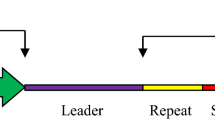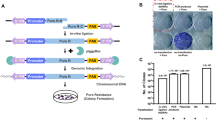Abstract
A human episomal sequence (HALF1) has been identified by its ability to restore expression of hepatic functions when used to transfect a rat dedifferentiated cell line. The genomic equivalent of this human episome (gHALF1) and its flanking sequences were analyzed. HALF1 itself does not present the characteristics of a transposable element but half of its sequence corresponds to retroposons, including Alu and L1 repeats and a processed pseudogene, known to transposevia RNA intermediates. The structural characteristics of these different kinds of retroposons and their origin and evolution were analyzed.
Similar content being viewed by others
References
Bailey, A. D. & C. K. Shen, 1993. Sequential insertion of Alu family repeats into specific genomic sites of higher primates. Proc. Natl. Acad. Sci. USA 90: 7205–7209.
Bellanné-Chantelot, C., B. Lacroix, P. Ougen, A. Billault, S. Beaufils, S. Bertrand, I. Georges, F. Gilbert, I. Gros, G. Lucotte, L. Susini, J. J. Codani, P. Gesnouin, S. Pook, G. Vaysseix, J. LuKuo T. Ried, D. Ward, I. Chumakov, D. Le Paslier, E. Barillot & D. Cohen, 1992. Mapping the whole human genome by fingerprinting yeast artificial chromosomes. Cell 70: 1059–1069.
Bernardi, G., B. Olofson, J. Filipski, J. Zerial, J. Salinas, G. Cuny, M. Meunier-Rotival & F. Rodier, 1985. The mosaic genome of warm-blooded vertebrates. Science 228: 953–958
Boccaccio, C., F. Apiou, J. Deschatrette, A. Aurias & M. Meunier-Rotival, 1994. Chromosomal localization and sequence analysis of a human episomal sequence within vitro differentiating activity. Somat. Cell Molec. Genet. 20: 163–170.
Boccaccio, C., J. Deschatrette & M. Meunier-Rotival, 1990. Empty and occupied insertion site of the truncated LINE-1 repeat located in the mouse serum albumin-encoding gene. Gene 88: 181–186.
Britten, R. J., W. F. Baron, D. B. Stout & E. H. Davidson, 1988. Sources and evolution of human Alu repeated sequences. Proc. Natl. Acad. Sci. USA 85: 4770–4774.
Deininger, P. L., M. A. Batzer, C. A. Hutchison III & M. H. Edgell, 1992. Master genes in mammalian repetitive DNA amplification. Trends Genet. 8: 307–311.
Dessen, P., C. Fondrat, C. Valencien & C. Mugnier, 1990. Bisance: a French service for access to biomolecular databases. Cabios 6: 355–356.
Dombroski, B. A., S. L. Mathias, E. Nanthakumar, A. F. Scott & H. H. Kazazian, 1991. Isolation of an active human transposable element. Science 254: 1805–1807.
Hattori, M., S. Kuhara, O. Takenaka & Y. Sakaki, 1986. L1 family of repetitive DNA sequences in primates may be derived from a sequence encoding a reverse transcriptase-related protein. Nature 321: 625–628.
Holmquist, G. P., 1992. Chromosome bands, their chromatin flavours and their functional features. Am. J. Hum. Genet. 51: 17–37.
Jurka, J., 1989. Subfamily structure and evolution of the human L1 family of repetitive sequences. J. Mol. Evol. 29: 496–503.
Jurka, J. 1993. A new subfamily of recently retroposed human Alu repeats. Nucleic Acids Res. 21: 2252.
Jurka, J. & A. Milosavljevic, 1991. Reconstruction and analysis of human Alu genes. J. Mol. Evol. 32: 105–121.
Jurka, J. & T. Smith, 1988. A fundamental division in the Alu family of repeated sequences. Proc. Natl. Acad. Sci. USA 85: 4775–4778.
Jurka, J., J. Walichiewicz & A. Milosavljevic, 1992. Prototypic sequences for human repetitive DNA. J. Mol. Evol. 35: 286–291.
Korenberg, J. R. & M. C. Rykowski, 1988. Human genome organization: Alu, LINEs and the molecular structure of metaphase chromosome bands. Cell 53: 391–400.
Leeflang, E. P., W.-M. Liu, C. Hashimoto, P. V. Choudary & C. W. Schmid, 1992. Phylogenetic evidence for multiple Alu source genes. J. Mol. Evol. 35: 7–16.
Matera, A. G., U. Hellmann, M. F. Hintz & C. W. Schmid, 1990. Recently transposed Alu repeats result from multiple source genes. Nucleic Acids Res. 18: 6019–6023.
Meunier-Rotival, M., P. Soriano, G. Cuny, F. Strauss & G. Bernardi, 1982. Sequence organization and genomic distribution of the major family of interspersed repeats of mouse DNA. Proc. Natl. Acad. Sci. USA 79: 355–359.
Ng, K. H., J. Maigné, M. Meunier-Rotival & J. Deschatrette, 1992. Cloning of a human DNA sequence that restores expression of hepatic functions in a defifferentiated rat hepatoma cell. Biochem. Bioph. Res. Commun. 188: 531–537.
Quentin, Y., 1992. Fusion of a free left Alu monomer and a free right Alu monomer at the origin of the Alu family in the primate genomes. Nucleic Acids Res. 20: 487–493.
Rogers, J. H., 1985. The origin and evolution of retroposons.. Int. Rev. Cytol. 93: 187–279.
Sakaki, Y., Y. Kurata, T. Miyake & K. Saigi, 1983. Two-dimensional gel electrophoretic analysis of the HindIII 1.8-kb repetitive-sequence family in the human genome. Gene 24: 179–190.
Scott, A. F., B. J. Schmeckpeper, M. Abdelrazik, C. T. Comey, B. O'Hara, J. P. Rossiter, T. Cooley, P. Heath, K. D. Smith & L. Margolet, 1987. Origin of the human L1 elements: proposed progenitor genes deduced from a consensus DNA sequence. Genomics 1: 113–125.
Singer, M. F., 1982. Highly repeated sequences in mammalian genomes. Int. Rev. Cytol. 76: 67–112.
Skowronski, J., T. G. Fanning & M. F. Singer, 1988. Unit-length LINE-1 transcripts in human teratocarcinoma cells. Mol. Cell Biol. 8: 1385–1397.
Skowronski, J. & M. F. Singer, 1986. The abundant LINE-1 family of repeated DNA sequences in mammals: genes and pseudogenes. Cold Spring, Harbor Symp. Quant. Biol. 51: 457–463.
Soriano, P., M. Meunier-Rotival & G. Bernardi, 1983. The distribution of interspersed repeats is nonuniform and conserved in the mouse and human genome. Proc. Natl. Acad. Sci. USA 80: 1816–1820.
Yamagishi, H., 1986. Role of mammalian circular DNA in cellular differentiation. Bioessays 4: 218–221.
Author information
Authors and Affiliations
Rights and permissions
About this article
Cite this article
Boccaccio, C., Deschatrette, J. & Meunier-Rotival, M. The human episome HALF1: Structure of its genomic counterpart. Genetica 93, 217–224 (1994). https://doi.org/10.1007/BF01435253
Received:
Accepted:
Issue Date:
DOI: https://doi.org/10.1007/BF01435253




